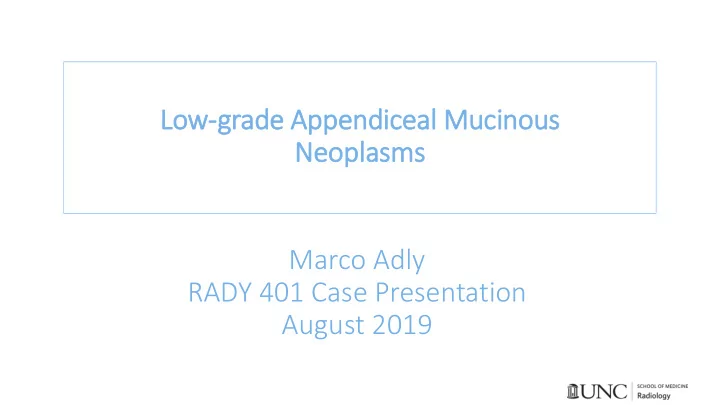

Low-grade Appendiceal Mucinous Neoplasms Marco Adly RADY 401 Case Presentation August 2019
Focused pati tient his istory • 54 y.o. female, began feeling right sided pain in March, thereafter began feeling more fatigued, experienced decreased appetite, n/v and constipation. Over the same time period, she noted weight gain and abdominal distension
Clinical Workup • LABS • MARKERS : CA19-9, CEA, CA 125 – ALL NEGATIVE • METABOLIC PANEL – MILD HYPONATREMIA – ALL OTHERS WNL • LIVER MARKERS: AST /ALT / ALP , PT/PTT/INR – ALL WNL • IMAGING • CT- ABD / PELVIS w/ IV + ORAL CONTRAST • Did they order the correct initial study?
ACR Appropriateness Criteria
In Initial CT CT Scan: Coronal Im Images +IV IV and Oral Contrast
In Initial CT CT Scan: Sagittal and Coronal Im Images +IV IV and Oral C
In Initial CT CT Scan: Axial Im Image +IV IV and Oral Contrast
In Initial CT CT Scan: Sagittal and Axial Im Images +IV IV and Oral C
In Initial CT CT Scan: Coronal Im Image +IV IV and Oral Contrast
Exploratory ry la laparotomy and ti tissue bio iopsy • SURGERY: Resection of masses and bilateral salpingo-oophorectomy • 40 lb post-op weight loss • normalized (return of) appetite • however, she continues to experience weakness and abdominal pain • FINAL PATHOLOGY • low grade mucinous ap appendiceal (NOT ovarian) neoplasm • ABD / PELVIS w/ IV + ORAL CONTRAST • Initial CT was reviewed: likely appendiceal mucocele, a descriptive term which refers to the appearance of a dilated mucin-filled appendix. • Postop CTs: see next slides. Chest CT negative
Follow-up CT CT Scan: Axial Im Image +IV IV and Oral Contrast
Follow-up CT CT Scan: Axial Im Images +IV IV and Oral Contrast
Follow-up CT CT Scan: Axial Im Images +IV IV and Oral Contrast
Follow-up CT CT Scan: Axial and Coronal Im Images +IV IV and Oral C
Take Home Poin ints: Appendiceal Mucinous Neoplasms • The spectrum of symptoms varies from vague abdominal pain, nausea, vomiting, and weight loss, to a palpable mass, abdominal distension, and acute appendicitis. • Vill Villous ad adenomatous ne neopla lastic ic ch changes of of the the ap appendic iceal ep epit itheliu ium • Highly associated with Pse seudomyxoma pe peri ritonei i o simple or loculated low attenuation mucinous fluid throughout peritoneum, omentum, and mesentery o exaggerated especially when metastasis to the ovaries (pseudomyxoma ovarii) Omental l cak akin ing o refers to infiltration of the omental fat by malignant soft-tissue density Appendiceal l muc ucocele descriptive term which refers to the appearance of a dilated mucin-filled appendix o more septated = increased risk of being a malignancy o
References https://radiopaedia.org/articles/omental-cake?lang=us https://radiopaedia.org/articles/low-grade-appendiceal-mucinous-neoplasm?lang=us https://radiopaedia.org/articles/pseudomyxoma-peritonei?lang=us Misdraji J. Appendiceal mucinous neoplasms: controversial issues. Arch. Pathol. Lab. Med. 2010;134 (6): 864-70. Arch. Pathol. Lab. Med. (link) Leonards LM, Pahwa A, Patel MK, Petersen J, Nguyen MJ, Jude CM. Neoplasms of the Appendix: Pictorial Review with Clinical and Pathologic Correlation. Radiographics : a review publication of the Radiological Society of North America, Inc. 37 (4): 1059-1083. doi:10.1148/rg.2017160150 Carr NJ, Cecil TD, Mohamed F, Sobin LH, Sugarbaker PH, González-Moreno S, Taflampas P, Chapman S, Moran BJ. A Consensus for Classification and Pathologic Reporting of Pseudomyxoma Peritonei and Associated Appendiceal Neoplasia: The Results of the Peritoneal Surface Oncology Group International (PSOGI) Modified Delphi Process. The American journal of surgical pathology. 40 (1): 14- 26. doi:10.1097/PAS.0000000000000535
Recommend
More recommend